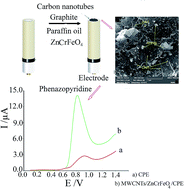Fast and selective determination of phenazopyridine at a novel multi-walled carbon nanotube modified ZnCrFeO4 magnetic nanoparticle paste electrode†
Abstract
In the present work, ZnCrFeO4 nanoparticles are synthesized via a sol–gel method. The resulting magnetic nanoparticles were characterized by field emission scanning electron microscopy (FE-SEM), X-ray diffraction (XRD) and Fourier transform infrared spectroscopy (FT-IR). Then, a novel phenazopyridine sensor was developed based on multi-walled carbon nanotubes modified with ZnCrFeO4 magnetic nanoparticles (MWCNTs/ZnCrFeO4/CPE). The modified electrode has a catalytic effect on the oxidation current of phenazopyridine and the oxidation mechanism was studied using cyclic voltammetry (CV), chronoamperometry and electrochemical impedance spectroscopy (EIS). Under the optimized chemical and instrumental conditions, the differential pulse voltammetry (DPV) response of the modified electrode toward phenazopyridine shows a linear concentration range from 0.3 to 625.0 μmol L−1 with a detection limit (3σ) of 0.02 μmol L−1. The proposed method was examined as a selective, simple and precise method for voltammetric determination of phenazopyridine in real samples with satisfactory results.


 Please wait while we load your content...
Please wait while we load your content...